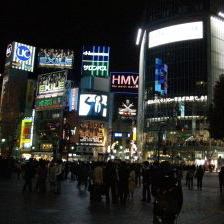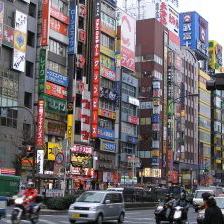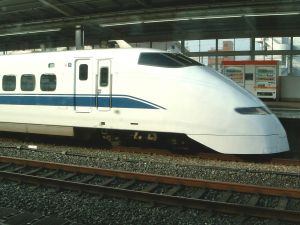 It’s no secret that Japan is an expensive destination.
It’s no secret that Japan is an expensive destination.
In fact, Tokyo has recently reclaimed its spot as the world’s most expensive city, with Osaka-Kobe right behind, according to the Worldwide Cost of Living Survey.
Well even in one of the world’s most expensive countries, a vacation doesn’t have to bring on budgetary meltdown.
We’ll show you how to defy the naysayers and survive your trip to Japan with a few extra bucks left in your wallet.
FIRST THINGS FIRST
Before you can even worry about where you’re going to eat or sleep, you’ve got to buy a plane ticket.
Luckily, if you know where to look, you can get one pretty cheaply. How cheap? Well, during the off season — for example, in March or April — prices frequently dip below $500. The secret is to use a Japanese travel agency.
Since these agencies buy tickets in bulk, their prices can be significantly cheaper than Orbitz or Expedia or other travel companies that don’t have a specific regional focus. These companies don’t devote much effort to advertising themselves in English, so few people know about the deals they offer.
Prices offered by different travel agencies can vary significantly, so if you’re truly devoted to truly cheap cheapness, we recommend that you proceed through the list below and obtain a quote from each and every agency before purchasing your ticket. Remember that you can always call the agency up and speak to them in English.
Amnet
(800) 929-2663
https://www.amnet-usa.com (Japanese)
HIS USA
(800) ASK-4-HIS
https://his-usa.com/ja/top/Top.aspx (Japanese)
IACE Travel USA
(800) 872-4223
https://www.iace-usa.com/index_us.htm (English version)
JTB USA
(800) 235-3523
https://www.jtbusa.com/enhome (English version)
Kintetsu International
(630) 250-8840
https://www.kintetsu.com (English)
NaviTour USA
(800) 303-2006
https://www.navitourusa.com/en/s.phtml (English)
One last note: international travel specialists like San Francisco-based Air Brokers (https://www.airbrokers.com) can sometimes beat the prices of even the Japanese travel agencies!
EAT CHEAP
It’s true that Japan is the land of $8 orange juice and $50 cantaloupe, and that food and drinks can be really expensive if you just go stumbling into any old place and blindly order items. But there are some ways to get a cheap meal in Japan…
Our first suggestion is to search out Japanese fast food chains like Matsuya and Yoshinoya. These places will serve you a beef bowl or a plate of curry for $4-$5. If you get tired of this fare, try convenience stores, which offer ready-made food of all kinds for decent prices.
 If you’re looking for something with a bit more culinary merit, try a kaitenzushi, a sushi restaurant where the food comes around to you on a conveyor belt, served on plates that are color-coded to indicate price. When your wallet is empty, stop eating. Ramen is another inexpensive option, and luckily the restaurant version tastes a lot better than the instant stuff sold in the US.
If you’re looking for something with a bit more culinary merit, try a kaitenzushi, a sushi restaurant where the food comes around to you on a conveyor belt, served on plates that are color-coded to indicate price. When your wallet is empty, stop eating. Ramen is another inexpensive option, and luckily the restaurant version tastes a lot better than the instant stuff sold in the US.
McDonald’s — a chain as ubiquitous in Japan as in America — is always a good bet for cheap eats, but it’s kind of a cop-out. I mean, having made the long journey to Japan, you wouldn’t even think of settling for a burger and fries, right?
Also note that in most Japanese restaurants, if they bring you any kind of appetizer, you’re going to have to pay for it. If you don’t want it, just say you don’t want it. Or put on an icky face and make frenzied “go away” motions with your hands.
SLEEP CHEAP
In Japan, as in most places, youth hostels are generally the cheapest option. Hostels.com (https://hostels.com) lists several establishments that’ll sell you a bed in Tokyo for less than $20. We hope this outrageous reasonableness comes as a pleasant surprise.
If you can’t or don’t want to stay in a youth hostel, try a business hotel. You should have no problem finding a room for less than $100. Do keep in mind that these places are pretty cramped. Bathrooms, for instance, are often little more than glorified shower stalls.
If you think a business hotel might fit your needs, take a look at Super Hotel’s English-language website (https://www.superhotel.co.jp/en). This chain does everything possible to cut costs, going so far as to eliminate phones in guests’ rooms. Prices vary based on location, but the cost for a room tends to hover right around $50. The English version of the website doesn’t feature all the chain’s locations, but it does list options at popular destinations.
There are plenty of interesting alternative choices.
Assuming you’re not claustrophobic, you might want to try a capsule hotel. Popular with drunken businessmen who’ve missed the last train, capsule hotels will offer you a space barely big enough to wriggle into, but they are inexpensive.
 Capsule hotels probably aren’t a good option for couples or families, since the environment isn’t suitable for kids and many don’t allow women. But if it works for you, expect to pay just about $30 a night.
Capsule hotels probably aren’t a good option for couples or families, since the environment isn’t suitable for kids and many don’t allow women. But if it works for you, expect to pay just about $30 a night.
Alternately, you could stay overnight at a love hotel. These are intended for couples in need of an hour or two of private time, but they offer nightly rates which can be significantly lower than those of regular hotels.
Love hotels list rates for “rest” and “stay.” The “rest” rate is the per-hour rate and the “stay” rate is for the full night.
A significant upshot to this choice is that these places are overflowing with, er, character. We’re talking heart-shaped beds and TV with all the channels. “Stay” rates average about $50.
If your luggage is light and you’re truly into pinching pennies, you could also spend the night at an internet/manga cafe, where you pay one flat fee to use the computer and read comics over a cup of tea for a fixed amount of time. Nobody’s going to think you’re weird if you do this.
Many of these places actually offer overnight packages, which can run as low as $10. Typically, you’ll get your own little cubicle with a reclining chair, and if you’re lucky, the place might even have a shower.
CHEAP TRANSPORTATION
Our first tip is to never even think about using a taxi. Banish the thought from your mind.
A taxi ride from Tokyo’s Narita airport into the city costs approximately $160 and takes about two hours. By contrast, a ticket on a non-express train costs $10-$12 and takes around an hour and a half. Now, in many other cities around the world, public transportation often isn’t the most pleasant or most efficient way to get around, but Japanese trains run on time, are very clean and go just about everywhere you want them to.
At most stations, you’ll buy your tickets from a machine that can display instructions in English. The only thing that’s annoying about relying on trains is that they generally stop running between midnight and 1:00 a.m. Taxis prowl the streets looking for those who’ve missed the cutoff.
 If your travel plans involve flitting around from city to city, you might save some money by purchasing a Japan Rail Pass (https://www.japanrailpass.net). Japan Rail, or JR, operates the majority of the rail lines in the country and can take you just about anywhere you want to go. Passes are sold in 7-day, 14-day, and 21-day increments. The nice thing is that the Japan Rail Pass is eligible for travel about the “shinkansen,” or bullet train, a super-fast, fun, and all-around really neat form of transportation that is ordinarily rather expensive. A 7-day Japan Rail Pass runs about $350. The pass is not sold in Japan, so you’ll need to pick one up before arriving there.
If your travel plans involve flitting around from city to city, you might save some money by purchasing a Japan Rail Pass (https://www.japanrailpass.net). Japan Rail, or JR, operates the majority of the rail lines in the country and can take you just about anywhere you want to go. Passes are sold in 7-day, 14-day, and 21-day increments. The nice thing is that the Japan Rail Pass is eligible for travel about the “shinkansen,” or bullet train, a super-fast, fun, and all-around really neat form of transportation that is ordinarily rather expensive. A 7-day Japan Rail Pass runs about $350. The pass is not sold in Japan, so you’ll need to pick one up before arriving there.
If you happen to be traveling to Japan during a school holiday, consider buying a seishun juhachi kippu (“18-year-old youth’s ticket”), a super-cheap, all-you-can-ride train pass. The passes are only available for purchase during school holidays (ie- they go on sale just before vacation starts, but most likely won’t be available at the very end of the vacation period).
The passes are only valid on JR’s slower trains. Despite the name, anybody can use a seishun juhachi kippu, and they are available for purchase at most JR stations. Each seishun juhachi kippu gives you five days of unlimited travel and costs about $100. Two or more people can use one ticket on the same day. For your reference, the school vacation schedule in Japan is roughly as follows:
March 1 – April 10
July 20 – September 10
December 10 – January 20
We’ll throw out one more option for those looking to travel long distances: the glorious overnight bus, a transport institution known and loved by Japan’s young and penniless. Overnight buses are uncomfortable and cramped but cheap. A trip from Tokyo to Osaka will set you back about $80, which is definitely less expensive than a trip by plane or shinkansen.
Japan Bus Web (https://www.bus.or.jp/e/index.html) operates a large English database chock full of detailed bus info.
OTHER STUFF
So you’ve probably got all kinds of ideas about stuff you want to do once you get to Japan. Unavoidably, most of that stuff is going to cost money. But don’t forget that people-watching can be an enjoyable–and completely free–activity. Great places to do this include Shibuya and Harajuku in Tokyo and America-mura in Osaka. Japan is full of colorful and crazy fashions and just sitting on the sidelines and watching the crowd can be pretty entertaining.
You might think about working some hiking and/or camping into your schedule. These activities are fun, provide you with opportunities to meet local people, and are cheap to boot. Check out Outdoor Japan (https://www.outdoorjapan.com) for some information on outdoor activities. And remember… it’s completely free to climb Mt. Fuji. Just remember to take your own drinks and snacks, since those sold onsite are way overpriced.
One final tip that may shave a few bucks off the total cost of your trip: although many people consider travelers’ checks an anachronism now that ATMs are so widespread, bringing traveler’s checks to Japan will net you a slightly better exchange rate. If you can get the traveler’s checks for free, you’ll save a little money in the end.
YOU CAN DO IT
Anybody who told you it couldn’t be done was just saying it to make themselves feel better. Cheap travel in Japan isn’t an impossibility. It takes dedication and planning and maybe a little self-deprivation, but in the end, returning home from such an ultra-expensive country with some change to spare is a pretty good feeling.
By Mike Day for Petergreenberg.com.
For more on Japan, see Off the Brochure Travel Guide: Tokyo, Japan.
Read more stories by Mike Day:












